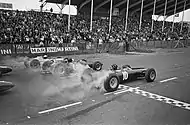Honda RA272
The Honda RA272 was a Formula One racing car designed by Yoshio Nakamura and Shoichi Sano for the 1965 Formula One season. It is best known for being the first Japanese car to win in Formula One.
 | |||||||||
| Category | Formula One | ||||||||
|---|---|---|---|---|---|---|---|---|---|
| Constructor | Honda | ||||||||
| Designer(s) | Yoshio Nakamura Shoichi Sano | ||||||||
| Predecessor | RA271 | ||||||||
| Successor | RA273 | ||||||||
| Technical specifications | |||||||||
| Chassis | Aluminium monocoque | ||||||||
| Suspension (front) | Double wishbone | ||||||||
| Suspension (rear) | Double wishbone | ||||||||
| Length | 3,950 mm | ||||||||
| Width | 1,675 mm | ||||||||
| Height | 793 mm | ||||||||
| Wheelbase | 2,300 mm | ||||||||
| Engine | Honda RA272E 1.5 L (92 cu in) V12 (60°) Naturally aspirated, Mid-engined, transversely mounted | ||||||||
| Transmission | Honda 6 forward speeds + 1 reverse | ||||||||
| Weight | 498 kg | ||||||||
| Fuel | BP | ||||||||
| Lubricants | BP | ||||||||
| Tyres | Goodyear | ||||||||
| Competition history | |||||||||
| Notable drivers | |||||||||
| Debut | 1965 Monaco Grand Prix | ||||||||
| |||||||||
Concept
A successor to the Honda RA271, the RA272 was noticeable mainly for its technically advanced (though rather wide and heavy) 48-valve 1,495.28 cc V12 engine (58.1 x 47.0 mm), a water-cooled, transversely mounted unit which reportedly gave 230 bhp (170 kW) at 13,000 rpm.[1] The engine was safe to 14,000 rpm, which was unusually high for a 1960s engine design.
Racing history
For their second season in 1965, Honda signed Richie Ginther – who had scored multiple podium finishes and had a reputation for being a great test and development driver – to drive alongside Ronnie Bucknum.
The car made its debut at the second round of the season in Monaco. The race ended in a double retirement as the cars suffered gearbox and transmission issues. Ginther qualified fourth at the next race in Belgium, and finished the race in sixth to give Honda their first points finish in Formula One.
The next race in France ended with ignition problems for both drivers, after a best qualifying position of seventh by Ginther. At the following British Grand Prix, Ginther qualified an impressive third, just 0.5 seconds off pole position, but the race again ended up in a retirement, this time caused by injection issues.

Ginther once again qualified third at the Dutch Grand Prix. He shot into the lead for the first two laps, but eventually finished sixth to score more points.
The team didn't participate in the German Grand Prix, but returned for the next race in Italy. In Italy, Bucknum qualified sixth – ahead of Ginther – after not participating in the last three races, but both cars retired from the race with ignition problems. Ginther qualified third in the United States Grand Prix, but finished seventh.
The following Mexican Grand Prix was going to be the final race of the season and also the final of the 1,500cc era. Ginther again qualified third and after he took the lead on the first lap, led every lap to win the Grand Prix.[2] Bucknum finished fifth to make it a double points finish. It was a historic moment, as it was the first Grand Prix victory for a Japanese team, car and engine. It was also Goodyear's first Formula One win.
The Honda RA272E V12 had staggering acceleration and often led the race into the opening lap after leaving the stationary starting grid. Despite not participating in every race, Honda finished their second season in Formula One sixth in the constructors' championship.[3]
Other
Honda's Type R cars traditionally have a Championship White paint option and a red Honda badge as a tribute to the RA272.
The RA272 appeared in the Formula One Championship Edition video game.[4] It also serves as the design influence for the B Dasher kart in the Mario Kart series.
Pictures
 The RA272 on display at the Honda Collection Hall
The RA272 on display at the Honda Collection Hall Rear-left view of the RA272
Rear-left view of the RA272 View of the cockpit
View of the cockpit The RA272 being driven at Goodwood in 2014
The RA272 being driven at Goodwood in 2014 Side view of the car
Side view of the car The RA272 at the start of the 1965 Dutch Grand Prix
The RA272 at the start of the 1965 Dutch Grand Prix
Formula One World Championship results
(key) (Races in italics indicate fastest lap)
| Year | Entrant | Engine | Drivers | Tyres | 1 | 2 | 3 | 4 | 5 | 6 | 7 | 8 | 9 | 10 | Pts. | WCC |
|---|---|---|---|---|---|---|---|---|---|---|---|---|---|---|---|---|
| 1965 | Honda R & D Company | Honda RA272E 1.5L V12 | G | RSA | MON | BEL | FRA | GBR | NED | GER | ITA | USA | MEX | 11 | 6th | |
| Richie Ginther | Ret | 6 | Ret | Ret | 6 | Ret | 7 | 1 | ||||||||
| Ronnie Bucknum | Ret | Ret | Ret | Ret | 13 | 5 | ||||||||||
References
- Franchitti, Dario (April 2012). "1965 RA 272". Road & Track. 63 (8): 76–79. Archived from the original on April 14, 2012. Retrieved April 5, 2012.
- "Standings". Formula1.com. Retrieved 2019-06-17.
- "Standings". Formula1.com. Retrieved 2019-06-17.
- "IGCD.net: Vehicles/Cars list for Formula One Championship Edition". www.igcd.net. Retrieved 2019-06-27.
